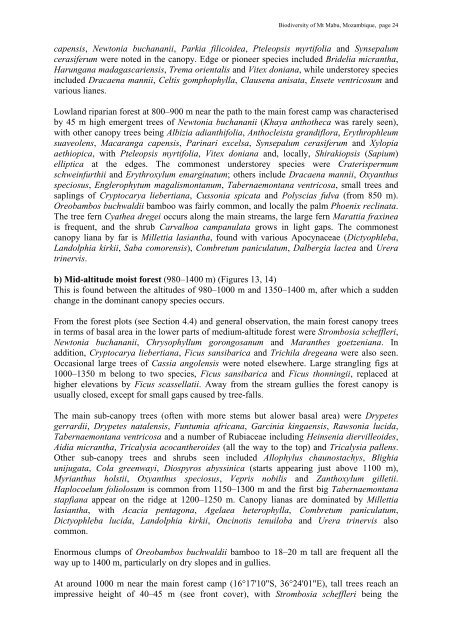MT MABU, MOZAMBIQUE: - Royal Botanic Gardens, Kew
MT MABU, MOZAMBIQUE: - Royal Botanic Gardens, Kew
MT MABU, MOZAMBIQUE: - Royal Botanic Gardens, Kew
Create successful ePaper yourself
Turn your PDF publications into a flip-book with our unique Google optimized e-Paper software.
Biodiversity of Mt Mabu, Mozambique, page 24<br />
capensis, Newtonia buchananii, Parkia filicoidea, Pteleopsis myrtifolia and Synsepalum<br />
cerasiferum were noted in the canopy. Edge or pioneer species included Bridelia micrantha,<br />
Harungana madagascariensis, Trema orientalis and Vitex doniana, while understorey species<br />
included Dracaena mannii, Celtis gomphophylla, Clausena anisata, Ensete ventricosum and<br />
various lianes.<br />
Lowland riparian forest at 800–900 m near the path to the main forest camp was characterised<br />
by 45 m high emergent trees of Newtonia buchananii (Khaya anthotheca was rarely seen),<br />
with other canopy trees being Albizia adianthifolia, Anthocleista grandiflora, Erythrophleum<br />
suaveolens, Macaranga capensis, Parinari excelsa, Synsepalum cerasiferum and Xylopia<br />
aethiopica, with Pteleopsis myrtifolia, Vitex doniana and, locally, Shirakiopsis (Sapium)<br />
elliptica at the edges. The commonest understorey species were Craterispermum<br />
schweinfurthii and Erythroxylum emarginatum; others include Dracaena mannii, Oxyanthus<br />
speciosus, Englerophytum magalismontanum, Tabernaemontana ventricosa, small trees and<br />
saplings of Cryptocarya liebertiana, Cussonia spicata and Polyscias fulva (from 850 m).<br />
Oreobambos buchwaldii bamboo was fairly common, and locally the palm Phoenix reclinata.<br />
The tree fern Cyathea dregei occurs along the main streams, the large fern Marattia fraxinea<br />
is frequent, and the shrub Carvalhoa campanulata grows in light gaps. The commonest<br />
canopy liana by far is Millettia lasiantha, found with various Apocynaceae (Dictyophleba,<br />
Landolphia kirkii, Saba comorensis), Combretum paniculatum, Dalbergia lactea and Urera<br />
trinervis.<br />
b) Mid-altitude moist forest (980‒1400 m) (Figures 13, 14)<br />
This is found between the altitudes of 980–1000 m and 1350–1400 m, after which a sudden<br />
change in the dominant canopy species occurs.<br />
From the forest plots (see Section 4.4) and general observation, the main forest canopy trees<br />
in terms of basal area in the lower parts of medium-altitude forest were Strombosia scheffleri,<br />
Newtonia buchananii, Chrysophyllum gorongosanum and Maranthes goetzeniana. In<br />
addition, Cryptocarya liebertiana, Ficus sansibarica and Trichila dregeana were also seen.<br />
Occasional large trees of Cassia angolensis were noted elsewhere. Large strangling figs at<br />
1000–1350 m belong to two species, Ficus sansibarica and Ficus thonningii, replaced at<br />
higher elevations by Ficus scassellatii. Away from the stream gullies the forest canopy is<br />
usually closed, except for small gaps caused by tree-falls.<br />
The main sub-canopy trees (often with more stems but alower basal area) were Drypetes<br />
gerrardii, Drypetes natalensis, Funtumia africana, Garcinia kingaensis, Rawsonia lucida,<br />
Tabernaemontana ventricosa and a number of Rubiaceae including Heinsenia diervilleoides,<br />
Aidia micrantha, Tricalysia acocantheroides (all the way to the top) and Tricalysia pallens.<br />
Other sub-canopy trees and shrubs seen included Allophylus chaunostachys, Blighia<br />
unijugata, Cola greenwayi, Diospyros abyssinica (starts appearing just above 1100 m),<br />
Myrianthus holstii, Oxyanthus speciosus, Vepris nobilis and Zanthoxylum gilletii.<br />
Haplocoelum foliolosum is common from 1150–1300 m and the first big Tabernaemontana<br />
stapfiana appear on the ridge at 1200–1250 m. Canopy lianas are dominated by Millettia<br />
lasiantha, with Acacia pentagona, Agelaea heterophylla, Combretum paniculatum,<br />
Dictyophleba lucida, Landolphia kirkii, Oncinotis tenuiloba and Urera trinervis also<br />
common.<br />
Enormous clumps of Oreobambos buchwaldii bamboo to 18–20 m tall are frequent all the<br />
way up to 1400 m, particularly on dry slopes and in gullies.<br />
At around 1000 m near the main forest camp (16°17'10"S, 36°24'01"E), tall trees reach an<br />
impressive height of 40–45 m (see front cover), with Strombosia scheffleri being the

















